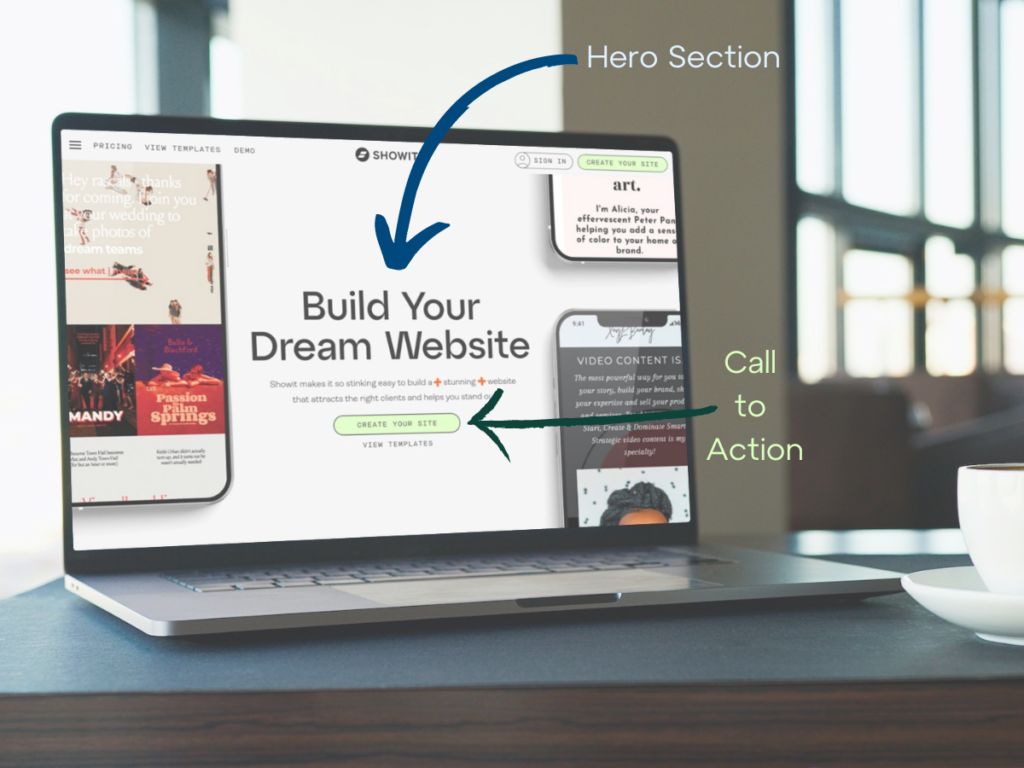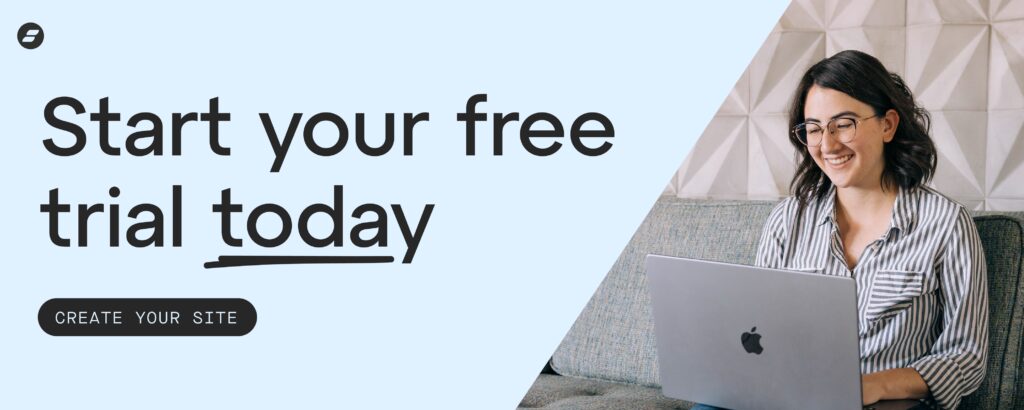So, you want to put together a website design portfolio that will sell your services to your ideal client? Great! But where are you even supposed to start?
The actual process of putting together your website design portfolio might not be as stressful or overwhelming as you think. It should, however, be a conscious project with a few important points you must consider: which projects you’ll feature, which projects you’ll leave out, and what else besides the mockups themselves you should have on the page.
Here are our tips for creating an impactful website design portfolio.

Why Website Designers Need an Online Portfolio
Every creative professional needs a portfolio that gives your ideal clients a feel for what you do — and that includes website designers.
Displaying your portfolio online as a part of your website gives people an idea of your skills and your specialties. It assures them you are able to do what you say you can.
Plus, it might inspire them to trust a professional in general. Many businesses might be inclined to use a website template or try designing their site themselves with an amateur-friendly platform. But once they see your professionally designed work done on Showit, they will be quickly convinced that having you handle this project for them will elevate their business higher.
The 5 Key Elements of a Website Design Portfolio
The layout of your portfolio website is completely up to you, but there are a few essential elements that most people have come to expect — and for good reason. They make it easy for potential clients to get an idea of who you are and why they should choose you over a competitor.
Here are five key elements you should include in your web designer portfolio:
- Hero Section: At the top of the landing page, this section should have a clever title (beyond the boring old “My Portfolio”) as well as a subhead or slogan that sums you up as a creative. You also might want to include a logo or image of some kind.
- Featured Projects: This is the substance of your portfolio — the part where you actually show off the projects you want people to see.
- Testimonials / Social Proof: Include testimonials from happy clients or even a few statistics on how your design improved their business success.
- About Section: This part doesn’t have to be long, but you should include at least a paragraph about your portfolio, why you chose the projects you did, and what clients can expect from the process of working with you.
- Call to Action: Finally, here’s the most important part. Encourage people to reach out if they like your work, and make your contact information easily available, whether through a form submission or direct contact, such as your email and phone number.

How to Create a Portfolio That Wows Your Ideal Web Design Clients
Your online portfolio is a reflection of you — it’s about your unique skill set as a designer!
So, of course, you’re going to want to create a portfolio that gives people an idea of how you’re different from other designers out there. It should reflect your creativity. It should show how you have your own unique style, plus how you’re able to capture a client’s unique vision.
This is the fun part because you’re limited only by your imagination. (Remember, Showit gives you complete creative control as a website designer, so you can really show off your design work in the portfolio section of your website.)
Ready to put together the ideal portfolio? Here are some of our top tips.
1. Feature Clients Who Represent Your Ideal Audience
Think about your goals as a designer. What projects do you specialize in, and which projects would you want to do more of? If you love designing websites for wedding photographers, for example, be sure to feature wedding photography websites prominently.
It doesn’t matter whether you’ve managed to establish a niche or not. If you had even one opportunity to design a website for a restaurant, but you want to land more restaurant clients — by all means, feature that one restaurant website prominently in your portfolio!
The advice goes both ways, of course. If you ever did a project that you really didn’t click with, and you want to avoid similar projects, you shouldn’t feature that website in your portfolio (even if you did a great job on it).
2. Choose a Sampling of Your Very Best Work
Maybe you’ve had a long and successful design career up to this point. That’s great, but you should avoid featuring every website you’ve ever designed in your portfolio. It’s just overwhelming! Remember that in these situations, less is more. Stick to a small number of your best work.
Of course, “a small number” can be relative. Maybe you’re a designer who has three or four examples that adequately reflect your work. Or maybe you need a few more examples to show people what you’re capable of.
Pro tip: You can use canvas views on Showit to let people scroll through your portfolio horizontally, instead of cluttering up the screen with so many examples shown vertically.

3. Include Context for Each Project
Giving context to your work helps your web visitors understand what you do as a designer. Make sure each website design in your portfolio is accompanied by succinct copy in which you describe what the client had in mind and how you brought that to life.
This will help potential clients appreciate your ability to grasp and visualize ideas — and they’ll be excited to see what you’re able to do with the concept they have in mind for their own business.
4. Show Off Your Personality
Remember that your portfolio is supposed to reflect your personal brand, so don’t let it be austere or cookie-cutter. Show off your personality! Use creative copy, your personal brand colors, and other fun design elements to give potential customers an idea of what it’s like to work with you.
Pro tip: Easily apply your branding to your portfolio page using Showit’s Design Settings!
5. Include Website Mockups
A mockup of the websites you’ve designed will give people a visual of what you’re able to do. You can even take a screenshot of the finished product and place it next to rough drafts or mood boards you did beforehand to get the actual look just right.

6. Use Your Clients’ Own Words
Your clients probably have great things to say about how you were patient with them, understood their concepts, and accommodated their revision requests. They also might be ready to brag about how having a website designed by you has changed their business! Be sure to get these written or video testimonials from your clients so you can include them in your portfolio.
Pro tip: This would be another great opportunity to use canvas views to feature multiple testimonials in one canvas.
7. Make Your Portfolio Easy to Find
Word of mouth is powerful, but you also want to make it easy for random web visitors to stumble upon you — and the way to do that is through search engines. Be sure to optimize your portfolio for Google with elements like alt text and keyword captions. You should also link to your portfolio in both the menu and footer of your website.
Pro tip: Optimize your portfolio page with ease using Showit’s simple SEO tools!
8. Make It Look Good on Mobile
What looks good on a laptop or desktop doesn’t always look great on a phone. That can be a real problem when you consider the fact that 92% of internet users might be looking at a phone for their browsing experience.
This is another good reason to keep your portfolio pared down. Scrolling through too many examples gets tedious enough on a desktop, but it’s especially bad on the small screen of your phone.
Pro tip: Showit allows different designs on mobile vs desktop, so you can easily customize your users’ experience on different devices!
9. Build Backlinks
Backlinks are great for SEO. Make sure each mockup in your portfolio is linked to your client’s actual website. You should also encourage them to link back to yours for extra traffic and SEO benefit.

10. Keep Your Portfolio Up to Date
Regular upkeep takes a bit of effort, but it’s so necessary — you don’t want an outdated portfolio! Take the time every few months to go through and update your portfolio, so you can take down outdated projects and add new ones.
Build Your Website Design Business with Showit!
If you’re a website designer who’s ready to grow your business, you’ll find everything you need on our platform here at Showit. We give you full creative control to design the websites of your clients’ dreams. Plus, you can create your own website to showcase the websites you design for other people!
Check out the top 9 features designers love about Showit to see if our platform could be the right fit for your own design business.
Curious about everything you can do with Showit? We offer a free trial with absolutely no strings attached. Be sure to check it out and start designing today!

Casandra is a born and bred East Coaster who finds herself braving the heat of the Valley of the Sun with her husband and three cute kids all for the love of Showit.
